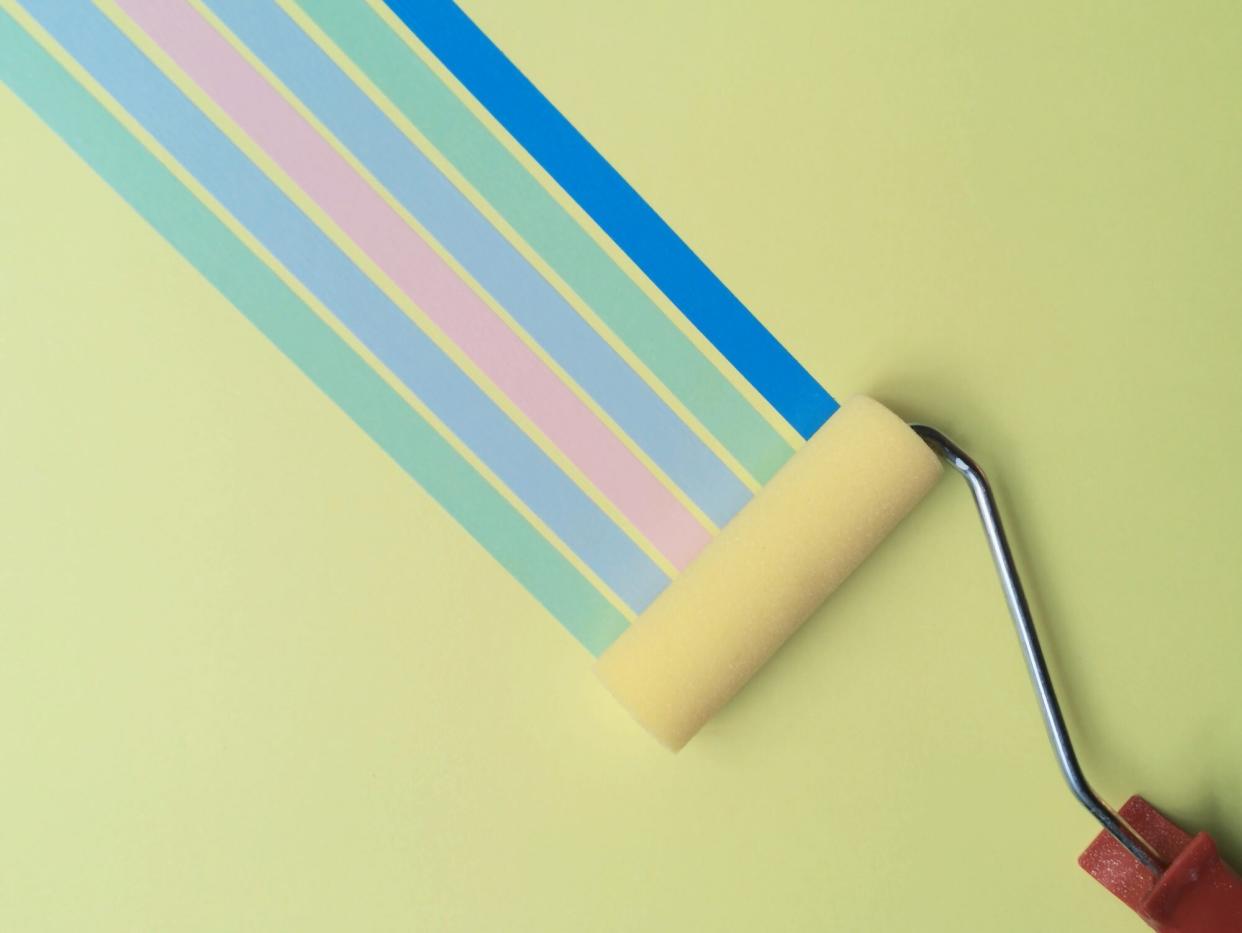Paint Your Walls Like a Pro: 8 Tips to Keep in Mind

Getty Images.
1. Gather All Your Supplies
Setting yourself up for success means starting out with the right tools. Beverley Kruskol, owner of M.Y. Pacific Building, Inc. and a general contractor in Los Angeles, California, suggests you get the following from your local home improvement store or online:
A pack of mini rollers (aka "weenie rollers") with frames
9" rollers with frames
A paint grid
A bucket for mixing the paint
A strainer to remove possible debris from the paint before it's applied
A quality step ladder
Blue painter's tape
Plastic to cover furniture and other items
Drop cloths and/or rosin paper
A pole/extension for your roller
Clothing you don't mind getting dirty
Bailey Carson, home care expert with Angi, recommends adding:
Sandpaper to remove previous imperfections on your walls
Spackling paste to patch holes
Caulking to seal noticeable cracks in seams and corners
2. Think About the Color and Finish
As for the paint itself, Kruskol suggests a flat finish—also known as a matte finish—if you're doing a ceiling and walls. Matte also an ideal finish if you want something washable, because your little ones are notorious wall scribblers. And if you're painting baseboards, window casings, window sills, etc., choose to use a semi-gloss paint, which will pair nicely against a flat finish on your wall.
And when pinpointing the best color, think about how you want your space to feel, suggests Amy Studebaker, owner and principal designer of Amy Studebaker Design in St. Louis, Missouri. She recommends first asking yourself if you want a warm and cozy feel or a cooler vibe.
"If warm and cozy is what you are after, go for colors that have a muddy feel with undertones of red, orange, or yellow," says Studebaker. "If the cooler vibe is what you are leaning towards, go for colors with a purple, blue, or green undertone."
3. Test, Test, Test
Once you've decided on a color, it's crucial to take it for a test drive, explains Matt Kunz, President of Five Star Painting, a Neighborly company.
"If you have decided on a color, you need to test it using a poster board or large areas of the wall," explains Kunz. "This way you can see it in its true form."
Why this is so important: "Many homeowners select colors that don't work once they are done, which can result in redoing the entire project, and nobody wants to do this task twice," he notes.
RELATED: Painting 101: Tips and Tricks for Updating Any Space
4. Pick Your Primer, If Necessary
Once you've chosen the paint, you'll also want to pick out a primer that's compatible. Carson points out that there are two common types of primer: oil-based and latex-based.
The primer you choose should be compatible with your paint based on its chemical makeup. "The surface you're painting will determine which kind of primer to use," she explains. "Either will work if you're painting new wood, but if you're painting drywall, for example, latex primer is a better bet because it will create a more even surface than oil-based products. Shiny materials, such as glass or tile, will require bonding primers."
That being said, if you're painting over a previously painted wall, there's no need to worry about a primer. "New paint adheres perfectly well to old coats."
5. Prep
Set the stage for success by decluttering. "The less clutter you have around, the better," says Carson. "Also, be sure to cover floors with drop cloths and furniture with plastic to avoid getting paint in the wrong places."
Then, before you pick up your paint brush, make sure you start with even, smoothed surfaces, she notes. "Sand any imperfections and patch holes for a more seamless application," says Carson.
6. Work Your Way From The Top Down
Once you begin painting, you'll want to work your way from the top down, explains Carson. "If you're painting the ceiling, start there," she notes. "Next, frame the room by painting the perimeter of the ceiling to ensure all seams are covered. Then, start in one corner and expand outward. Replicate that same process for the walls."
She continues, "Frame them first by cutting around moldings, wall fixtures and door and window frames before rolling out the walls. Add a second coat, and then, proceed to the trim."
As for the actual application technique, aim for vertical strokes. Try to work as quickly as possible and maintain a wet edge to keep the color consistent, explains Carson. Check your paint packaging for the length of time it will take your particular product to dry as it will vary.
And if you're a novice painter, give yourself extra leeway by using plenty of two-inch blue painter's tape along any edges. "Consider running tape on the floor, especially if you have hardwood floors," she adds.
7. Leave Enough Time Between Coats
If there isn't enough drying time between coats, wrinkling can happen, explains Kunz. "So be sure to read recommended drying times carefully on the type of paint you choose for the project."
8. Clean Up and Store—or Recycle—Your Paint
Ultimately, if you've prepped your space well, cleanup will be far less time-consuming than it would be otherwise, notes Carson. And from there, you'll be free to kick back and enjoy your handiwork.

